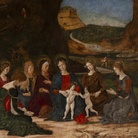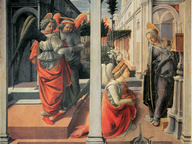A never seen before Warhol: the first digital experimentations with Amiga. A documentary exhibition in Milan

Andy Warhol, Autoritratto, 1985, Amiga 1000
From 21 Ottobre 2015 to 21 Novembre 2015
Milan
Place: Deodato Arte
Address: via Santa Marta 6
Times: Tue - Sat 10.30am-2pm and 3pm-7pm
Telefono per informazioni: +39 02 39521618
E-Mail info: galleria@deodato-arte.it
Official site: http://www.deodato.com
For the first time in Italy, thanks to Deodato Arte, a group of never seen before works by Warhol.
The exhibition celebrates the 30 year anniversary of the presentation of Amiga 1000 at the Lincoln Center of New York and recreates the original contest where the artist began to experiment with digital art and became fond of it.
With this important event the Deodato Arte Gallery opens its new venue in the very centre of Milan, in via Santa Marta.
On display there are two historical Amiga 1000 personal computers from 1985 in which the visitor can admire 9 never seen before works, which were elaborated by Warhol, 16 acetate works of which 6 never seen before from the series Ladies and Gentleman, which portray models and drag queens, hired for the project, posing like the celebrities known by Warhol, silkscreen prints, records,$2 and Italian £100.000 notes, as well as a rich documentation consisting of photographs, videos, the issue of the magazine “Amiga Word” with the interview of the Pop Art icon, some issues of the monthly magazine “Interview”, and invitation cards of Leo Castelli.
Along the exhibition there is the tribute by the photographer, printer and artist Giuliano Grittini, known for his partnerships with many artists among which there is Warhol, of whom for the occasion he printed and redesigned 10 computer art works through mixed techniques.
On July 23, 1985 Commodore launched the Amiga 1000, the first multimedia personal computer, and for the big event they invited Andy Warhol to create a work at the Vivian Beaumont Theater: for the occasion they took a black and white picture of Debbie Harry, lead singer of the band Blondie, through a camera connected to a computer - a revolutionary technology at that time - and the artist worked on it through colour reprocessing, which made it the first Andy Warhol'scomputer-art work.
From that moment on until his death (1987), he experimented with great enthusiasm the potential of these revolutionary means, purchasing a whole lot of Amiga computers and making several modifications to his own works, among which there is the Cambpell's soup can, the banana on the cover of the Velvet Underground's album, Marilyn Monroe's portrait and many others, that still today are part of an undiscovered heritage.
Warhol's interest for this language is thoroughly expressed in his interview in 1986, published on “Amiga Word”, where when asked What are the things that you like the most about doing this kind of art on the Amiga? Warhol replied Well, I like it because it looks like my work,which emphasize the close connection with this very innovative new born technology, but which was especially close to his personal artistic way of expression.
After 1987, this group of works was temporarily forgotten and only through a long difficult process of data recovery, it was possible to return their content, part of which is on display at the exhibition, to the public.
The exhibition celebrates the 30 year anniversary of the presentation of Amiga 1000 at the Lincoln Center of New York and recreates the original contest where the artist began to experiment with digital art and became fond of it.
With this important event the Deodato Arte Gallery opens its new venue in the very centre of Milan, in via Santa Marta.
On display there are two historical Amiga 1000 personal computers from 1985 in which the visitor can admire 9 never seen before works, which were elaborated by Warhol, 16 acetate works of which 6 never seen before from the series Ladies and Gentleman, which portray models and drag queens, hired for the project, posing like the celebrities known by Warhol, silkscreen prints, records,$2 and Italian £100.000 notes, as well as a rich documentation consisting of photographs, videos, the issue of the magazine “Amiga Word” with the interview of the Pop Art icon, some issues of the monthly magazine “Interview”, and invitation cards of Leo Castelli.
Along the exhibition there is the tribute by the photographer, printer and artist Giuliano Grittini, known for his partnerships with many artists among which there is Warhol, of whom for the occasion he printed and redesigned 10 computer art works through mixed techniques.
On July 23, 1985 Commodore launched the Amiga 1000, the first multimedia personal computer, and for the big event they invited Andy Warhol to create a work at the Vivian Beaumont Theater: for the occasion they took a black and white picture of Debbie Harry, lead singer of the band Blondie, through a camera connected to a computer - a revolutionary technology at that time - and the artist worked on it through colour reprocessing, which made it the first Andy Warhol'scomputer-art work.
From that moment on until his death (1987), he experimented with great enthusiasm the potential of these revolutionary means, purchasing a whole lot of Amiga computers and making several modifications to his own works, among which there is the Cambpell's soup can, the banana on the cover of the Velvet Underground's album, Marilyn Monroe's portrait and many others, that still today are part of an undiscovered heritage.
Warhol's interest for this language is thoroughly expressed in his interview in 1986, published on “Amiga Word”, where when asked What are the things that you like the most about doing this kind of art on the Amiga? Warhol replied Well, I like it because it looks like my work,which emphasize the close connection with this very innovative new born technology, but which was especially close to his personal artistic way of expression.
After 1987, this group of works was temporarily forgotten and only through a long difficult process of data recovery, it was possible to return their content, part of which is on display at the exhibition, to the public.
SCARICA IL COMUNICATO IN PDF
COMMENTI

-
 Dal 20 dicembre 2024 al 04 maggio 2025
Fermo | Palazzo dei Priori
Dal 20 dicembre 2024 al 04 maggio 2025
Fermo | Palazzo dei Priori
-
 Dal 20 dicembre 2024 al 04 maggio 2024
Gorizia | Palazzo Attems Petzenstein
Dal 20 dicembre 2024 al 04 maggio 2024
Gorizia | Palazzo Attems Petzenstein
-
 Dal 18 dicembre 2024 al 18 dicembre 2024
Venezia | Museo Correr
Dal 18 dicembre 2024 al 18 dicembre 2024
Venezia | Museo Correr
-
 Dal 14 dicembre 2024 al 02 marzo 2025
Palermo | Palazzo Abatellis
Dal 14 dicembre 2024 al 02 marzo 2025
Palermo | Palazzo Abatellis
-
 Dal 12 dicembre 2024 al 23 febbraio 2025
Roma | Palazzo Altemps
Dal 12 dicembre 2024 al 23 febbraio 2025
Roma | Palazzo Altemps
-
 Dal 13 dicembre 2024 al 31 agosto 2025
Roma | Museo dell'Ara Pacis
Dal 13 dicembre 2024 al 31 agosto 2025
Roma | Museo dell'Ara Pacis


